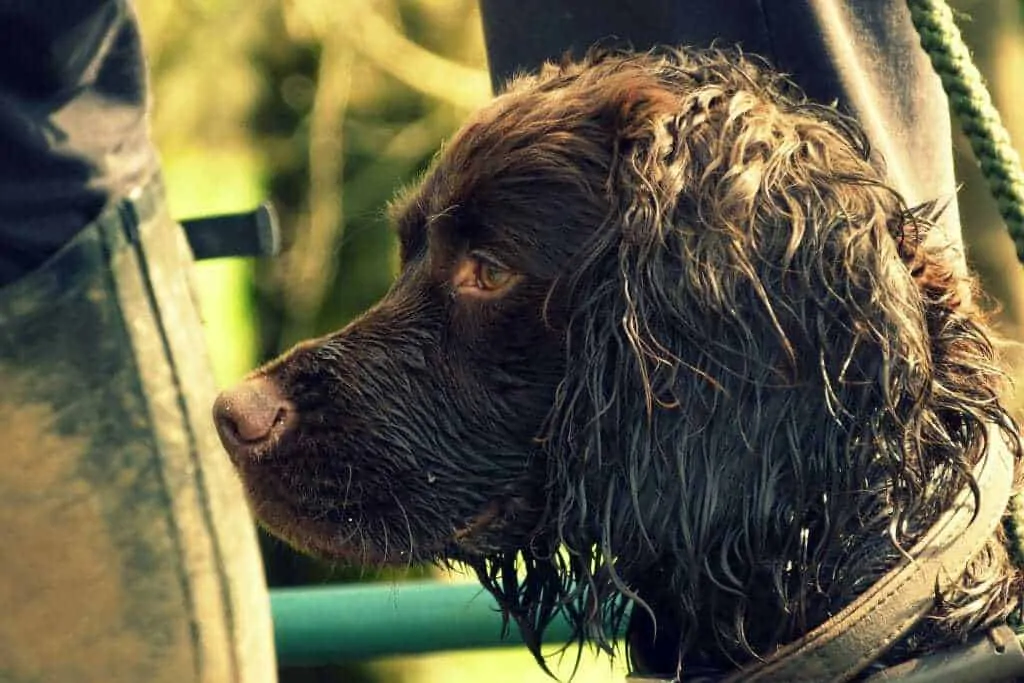Working dog breeds are intelligent, trainable, outgoing and high-energy dogs. The working dog class is extensive, made up of over 50 breeds including everything from the Old English Sheep Dog to the Komondor with their impressive coats, all of which would have been typically bred to carry out very specific jobs. This is also the case for other dog classes including terriers, traditionally bred to hunt vermin, hounds, historically used for hunting, pastoral/herding dogs who are still primarily used for herding livestock and sporting/gundogs that although make great companions would have once primarily been bred for hunting, flushing and retrieving game.
Now, although the breeds that make up these five classes are still bred around the world in a working capacity, they can also make wonderful family pets. As the owner of a working cocker spaniel, I am a big fan of these bright dogs that love their exercise and lots of mental and physical stimulation.
Alfie is a typical working spaniel and despite not being a formally trained gundog, he instinctively knows how to flush out game whilst out walking and is particularly skilled at retrieving socks!
Alfie the working cocker spaniel
In this article, I am going to discuss 15 things you need to know about working dog breeds across these classes if it’s one of these breeds that you are planning to welcome as part of your family.
Contents
1. We have been breeding working dogs for over 15,000 years
It is thought that the first dogs to be domesticated from their wolf ancestors occurred over 15,000 years ago. Bred to work alongside humans these very early dogs would have likely been used for jobs including hunting, guarding livestock and as companions. It was this early domestication of dogs that paved the way for the evolution to the hundreds of breeds we know and love today.
2. Exercise is key
Known for their high energy levels, workings breeds tend to require the most exercise of all dogs. Of course, how much exercise you give them every day is dependent on their breed, health and age but on average most working dog breeds will benefit from at least 1-2 hours of physical exercise daily.
The perfect amount of exercise is entirely dependent on your dogs breed, age, and health.
3. Mental stimulation is important too
For these brainy breeds, mental stimulation is just as important as physical exercise. This can include anything from making your dog work for their food, teaching them a new trick or giving them a puzzle to play with. Without mental stimulation, some working breeds can suffer from boredom and become destructive, or develop behavioural problems.
4. They can be trained to do almost anything
With so many breeds trained for very specific jobs from acting as search and rescue dogs to herding reindeer, it is no surprise that working dog breeds are one of the easiest to train. You may notice them picking up distinctive working traits of their breed almost instinctively and some capacity of training is extremely beneficial for all breeds of working dogs, who otherwise can be difficult to handle when left untrained.
From tricks to providing a specific service, working dog breeds are easy to train
5. Their stamina is something to be admired
In their traditional roles working dog breeds such as the Siberian Husky originally bred for sledging would have been expected to work for long periods. Their stamina is a common trait and is something that can be seen right across many working dog breeds who can keep going long after we humans have exhausted ourselves.
As with all dog breeds, working dogs are traditionally pack animals and in their traditional working circumstances, they would have been expected to get along with a group of dogs. However, as with any dog, socialization is key when it comes to making sure they can get along with other canine companions.
Working as a team is key for many working dog breeds
7. They have the ability to adapt well to new surroundings and situations
Let’s take for example the St. Bernard. A working dog breed originally bred as a search and rescue dog. At the drop of a hat, they would be expected to adapt, cope and work in unfamiliar surroundings with minimal fuss. Although the temperament of your dog can vary depending on their background, typically most working breeds are good a adapting to new surroundings and are unlikely to suffer from signs of anxiety.
St. Bernards working as search & rescue dogs in the Swiss Alps
8. Working breeds can have guarding traits
Many working dog breeds such as Doberman’s and Great Danes were traditionally and still are bred to work as a guard dog in some capacity. Heroic and loyal companions, such breeds will naturally act as very efficient guard dogs even without training.
9. Pastoral breeds are some of the most intelligent
With a history of being excellent herding dogs, pastoral breeds are well-known to be some of the most intelligent working dog breeds in the world, with the Border Collie coming in at number one. An ability to learn hand, voice and whistle signals they have excellent focus and are capable of making their own decisions when faced with a challenge.
Trained to herd large flocks of sheep efficiently, the Border Collie is crowned king when it comes to most intelligent dogs.
10. Hounds tend to be more independent
Bred to hunt either by sight or smell, many hound breeds are often described as aloof, yet dignified. However, despite this, breeds such as Beagles and Whippets often make excellent emotional support dogs.
11. Gundogs are often the most energetic
Despite being easy to train, the energies levels of gundogs can go through the roof, which means they can sometimes get a little over-excited, particularly if they catch the scent of a game bird or, as in the case of my Spaniel Alfie, playing with seaweed on the beach.
Alfie displaying the typical traits of a mad spaniel
12. Terriers may be small but they’re brave
Despite their size, Terrier breeds are known to be some of the bravest dogs out there. Breeds such as a border terrier would have typically been bred to hunt vermin and even fox, which makes it no surprise that you will regularly see a terrier ready to take on a dog twice their size.
13. They make wonderful family pets
Loyal and loving, working dog breeds have been bred for thousands of years to live and work alongside humans which is why that despite many of them no longer being bred to carry out their traditional working roles, they now make wonderful family pets.
With great temperaments, many working dog breeds make wonderful pets if you have a young family.
14. A working breed can make the perfect service dog
Their combination of trainability, loyalty, intelligence and stamina are just some of the reasons working dog breeds often make the best service dogs. You will frequently see breeds such as Golden Retrievers and German Shepherds supporting the visually impaired.
15. Loyalty is a typical trait amongst working dogs
As a part of their traditional roles working dog breeds will have always relied on their owners to look after them, which is why they regularly develop strong bonds with specific individuals and display unrelenting loyalty.






